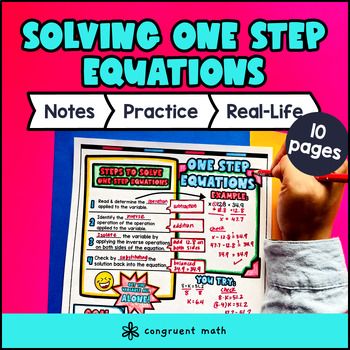Want more ideas and freebies?
Get my free resource library with digital & print activities—plus tips over email.
Join for Free Resources →
$4.25
Ever wondered how to teach one-step equations with positive solutions in an engaging way to your 6th-grade students?
In this lesson plan, students will learn about solving one-step equations and their real-life applications. Through artistic, interactive guided notes, checks for understanding, a doodle and color by number activity, and a maze worksheet, students will gain a comprehensive understanding of one-step equations.
The lesson culminates with a real-life example that explores how unit conversions can be applied in everyday situations. This lesson is not only effective for introductory lessons but also for reteaching, spiral review, homework, sub plans, and quiz, test, and exam preparation. By the end of the lesson, students will be able to confidently solve one-step equations with positive solutions.

$4.25
After this lesson, students will be able to:
Before this lesson, students should be familiar with:
As a hook, ask students why it is important to be able to solve one-step equations in real-life situations. Refer to the last page of the guided notes as well as the FAQs below for ideas.
Use the first page of the guided notes to introduce the steps to solve one-step equations. Walk through the process of isolating the variable using inverse operations. Emphasize the importance of performing the same operation on both sides of the equation to maintain equality.
Based on student responses, reteach any concepts that students need extra help with. If your class has a wide range of proficiency levels, you can pull out students for reteaching, and have more advanced students begin work on the practice exercises.
Have students practice solving one-step equations with positive solutions using the practice worksheet (page 2 of guided notes) included in the resource. The practice worksheets include color by code, maze, and problem sets for students to work on.
Walk around the classroom to answer any student questions and provide assistance as needed.
For fast finishers, they can further reinforce their skills by working on fun worksheets including color by number (page 3 of guided notes) and a maze activity (page 4 of guided notes). You can assign this activity as homework for the remainder of the class, allowing students to continue practicing and applying their knowledge.
Use the last page of the guided notes to bring the class back together, and introduce the concept of real-life applications of solving one-step equations with positive solutions. Explain to students that one-step equations can be used to solve problems in various real-life situations. For example, they can be used to solve problems related to buying items, calculating distances, or determining cooking measurements.
Encourage students to think about how they can use one-step equations in their daily lives. Ask them to share any real-life situations they can come up with where solving one-step equations with positive solutions would be helpful. This can be done through a class discussion or in small groups.
Refer to the FAQ section of the resource for additional ideas on how to teach real-life applications of solving one-step equations with positive solutions.
If you’re looking for digital practice for solving one-step equations with positive solutions, try my Pixel Art activities in Google Sheets. Every answer is automatically checked, and correct answers unlock parts of a mystery picture. It’s incredibly fun, and a powerful tool for differentiation.
Here’s 2 activities to explore:
A fun, no-prep way to practice one-step equations is Doodle Math — they’re a fresh take on color by number or color by code. It includes multiple levels of practice, perfect for a review day or sub plan.
Here are 2 activities to try:
One-step equations are equations that can be solved in a single step. They involve only one mathematical operation, such as addition, subtraction, multiplication, or division.
To solve a one-step equation, isolate the variable by performing the inverse operation of the mathematical operation given in the equation. The goal is to get the variable alone on one side of the equation.
Inverse operations are mathematical operations that "undo" each other. They are used to solve equations. For example, addition and subtraction are inverse operations, as are multiplication and division.
To check your solution to a one-step equation, substitute the value you found for the variable back into the original equation and simplify both sides. If both sides of the equation are equal, then your solution is correct.
Solving one-step equations has many real-life applications. For example, it can be used to calculate distances, solve word problems involving rates, or determine the time needed to complete a task.
Get my free resource library with digital & print activities—plus tips over email.
Join for Free Resources →